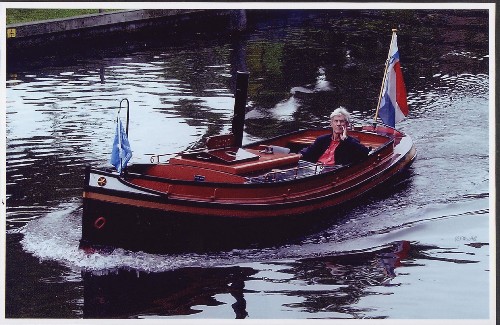(Note: As of March 2017, Yahoo Group mentioned below is no longer active. You still can read past conversations.)

So You Want to Build a Giant Pop Pop / Putt Putt Boat?
Before delving into scaling up the engines, I insist that you learn a new word: serendipity. Serendipity means we go looking for one thing, and perhaps we don’t find exactly that thing. But—if our minds are flexible enough to be open to it—we find something as good or better in the process of looking.
OK, many intelligent, curious people have wondered, “If pop pop boats are this cool, how cool would it be to make a person-sized pop pop boat?!” In fact, the idea has even seeped into popular culture. In the children’s animated movie Ponyo, the young heroes use magic to transform a toy putt putt boat into a big boat and ride in it.
Alas, those of us who are lacking in magical powers have to grapple with the persnickety laws of nature.
My friend David Halfpenny from England has some interesting things to say about the difficulty and hope of scaling up in general: I quote,
“There's a critical size for everything in nature. That's why you'll never see a moth as big as a dog - the insect respiration system just can't get enough oxygen.”
“There's an old joke that goes:‘According the laws of aerodynamics, a bumblebee cannot fly. Fortunately nobody has told the bee.’ Well actually, bees cannot fly, not like a bird or a plane - they 'swim' through the air, which, at their small size and low weight, is much stickier than it is to us. Or a bird. Or a dog. So that means there must be a crossover between Insect Size 'lungs' and Dog Size lungs, and sure enough you can get a beetle as big as a mouse.”
“In a wind tunnel (used to simulate aircraft flight), the airspeed isn't scaled in the same ratio as the aircraft model size. In an oil tunnel (used to understand insect-sized flight), the fact that oil has to be used instead of air speaks volumes about what it's like to be an insect.”
“It means there must be a crossover between Gnat Flight and The Flight of the Condor, and sure enough there is the Humming Bird - a bird so small it can swim though air as well as glide, and so skilled it can hover.”
Then my friend Jean-Yves Renaud from France adds some specifics:
Building a half meter engine should not be a problem. My bigger one (just to check that there is no limit) was approx 3m long. However, I must warn you about the performances. When the size of the engine increases, its thrust/weight or power/volume ratios decrease. In other words, for the same weight two small engines are better than a big one. The thrust doesn't increase much with the pipe ID though the weight does as well as the volume. The velocity of the jet decreases when the size of the engine increases. Multiple pipe engines and or multiple engines are to be preferred if performances (speed and thrust) are expected.
Jean-Yves has also measured the efficiency of pop pop engines and found them wanting. And he notes that pop pops do not reverse, and questions how long the appeal of being shaken back and forth several times a second will remain amusing. Oops, pop pop forum member
From Canada, my friend Daryl Foster has created some extraordinary engines with many pipes.
Look half a minute into this video and see the new world record holder for speed. Even veteran pop pop builders are amazed. How big a boat could that engine push?
So, at top of the page, what was all that about serendipity—discovering things while looking for something else?
All these friends I’ve quoted, and dozens more in various degrees of activity, are members of an informal e-mail group of pop pop enthusiasts scattered around the world. Despite the fact that I have only met one of the members in person, I do mean friends. We share a common bond. These charming boats have tickled our imagination we’re all and curious about what are the possibilities? There’s the serendipity. If you’ve come to this page you might not have found an easy answer the question of scale, but you have discovered a community of people who are finding out.
I rarely participate, but I get the e-mails automatically and I stay abreast of what’s going on. Sometimes the chatter is about a new discovery, sometimes there’s a contentious issue, sometimes there’s humor, sometimes the group goes into hibernation, sometimes the topics go careening delightfully off topic, and sometimes we welcome new members. So consider joining. It’s a Yahoo group that you have to join, but it’s free, and—other than being hosted by Yahoo for administrative convenience—non-commercial. As you might expect, there’s great archived threads and pictures.
P.S. Frank reminded me that Pop-pops member Richard Jenkins has demonstrated the possibility for using a remotely controlled Kitchen rudder to provide forward and reverse steering for a pop-pop boat.
Below is the video of boat that backs up before improvised substitute is removed.
And it was pointed out that--although Daryl might have the fastest pop pop--Matt Naiva and his son Willam built an awfully fast aluminum engine pop pop.
And that's without more than two pipes!
